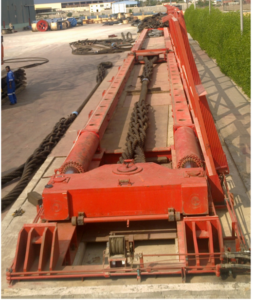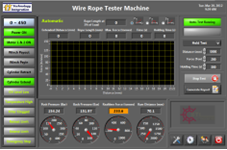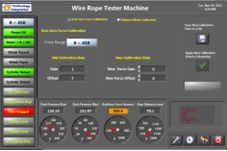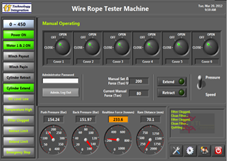
Wire Rope Tension Test Bed
KTL Offshore Company selected Technology Integration Company to do this application for the price competitiveness, the compact size and the reliability of the compact DAQ, and for the simplicity and user friendliness of the HMI.
The application consists of developing a system to control a 1000-tonne Test Bed, monitor the readings from the field, and runs automatic and manual wire rope tests.
Technology Integration developed the system utilizing National Instruments Compact DAQ, LabVIEW, PID and Report Generation Toolkits.
System Description:
Inputs and Outputs:
The system consists of 3 Analog Inputs, 2 Analog Outputs, 32 Digital Outputs and 24 Digital Inputs. The control system was developed using NI’s LabVIEW along with a Compact DAQ.
Control loops:
The application contains 2 PID control loops, with the ability to switch output control between Automatic and Manual in a bumpless way.
Software:
The software of this application was developed to control the tension test, monitor the readings and to generate the test reports. The software was divided into four main parts (pages) which are, Manual Operating Page, Automatic Operating Page, Calibration Page, and PID Parameters Page.
All the sensors’ readings, the statuses of the buttons, switches and the machine are updated continuously on the HMI regardless which page is open.
Manual Operating Page:
The Manual Operating Page has the Test Bed Covers’ controls from which the user can open or close the covers of the Test Bed and extend or retract the main cylinder manually. Extending the cylinder in the Manual Operating mode has two options Speed and Pressure; in the speed option the user can extend the cylinder in a fast way. In the Pressure option the operator has to enter a Force setpoint and the cylinder will extend until it reaches that setpoint using the PID Control loop. The Pressure option can be used in calibrating the machine.
Automatic Operating Page:
From the Automatic Operating page, the user can run an Automatic Test. He can select the test type, enter the test parameters and then run the test. During the test the user can see all the readings of the sensors and the status of the test from the indicators and the graphs available on this page.
Calibration Page:
In the calibration page, the user can calibrate the readings of the Force and Distance meter. He can apply/change Gain and/or Offset values to the reading.
PID Parameters Page:
In order to reach to the optimum behavior of the PID control loops, the user can change the PID parameters of the control loop from this page.
Advantages:
The combination of LabVIEW and compact DAQ gives the following advantages:
• Simple and user friendly HMI
• Easy to calibrate the sensors’ readings
• Easy to maintain
• Easy to expand
• Multi level security system
• Automatic and Manual Testing options
• Protecting the machine, product and the operators through number of safety features



